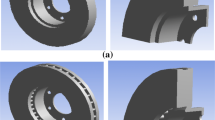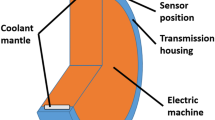Abstract
The heat dissipation of a ventilated disc on high-speed trains during emergency braking is studied to improve heat dissipation performance. The conjugate heat transfer method is employed to understand the distribution and variation of convective heat transfer coefficients on the disc surfaces during braking. Finite element models of the ventilated disc and the complicated air flow field under the train are built. Boundary conditions are derived based on real working conditions. Heat transfer simulation is carried out using the FLUENT computer code. Simulation results, including temperature rise of the disc, convective heat transfer coefficient distribution, and heat transfer rate, are presented and analyzed. Using materials with high thermal conductivity coefficients and reducing the heat transfer wall thickness of the disc are proposed to improve the heat dissipation performance of the disc based on the simulation results. Both methods are effective in improving the heat transfer rate of the disc with a 10% improvement in the improved thermal conductivity case and a 30% improvement in the reduced wall thickness case.
Similar content being viewed by others
References
R. Limpert, Brake design and safety, Second Ed. Society of automotive engineers Inc, Warrendale, USA (1999).
W. S. Chung, S. P. Jung and T. W. Park, Numerical analysis method to estimate thermal deformation of a ventilated disc for automobiles, Journal of Mechanical Science and Technology, 24(11) (2010) 2189–2195.
P. Hwang and X. Wu, Investigation of temperature and thermal stress in ventilated disc brake based on 3D thermal-mechanical coupling model, Journal of Mechanical Science and Technology, 24(1) (2010) 81–84.
M. Duzgun, Investigation of thermal-structural behaviors of different ventilation application on brake discs, Journal of Mechanical Science and Technology, 26(1) (2012) 235–240.
S. P. Jung, T. W. Park, J. B. Chai and W. S. Chung, Thermal-mechanical finite element analysis of hot judder phenomenon of a ventilated disc brake system, International Journal of Precision Engineering and Manufacturing, 12(5) (2011) 821–828.
Š. Blaž, O. Grega, L. Tone and P. Iztok, Numerical analysis of railway brake disc, Journal of Shanghai Jiaotong University (Science), 16(2) (2011) 149–151.
M. Pevec, I. Potrc, G. Bombek and D. Vranesevic, Prediction of the cooling factors of a vehicle brake disc and its influence on the results of a thermal numerical simulation, International Journal of Automotive Technology, 13(5) (2012) 725–733.
H. Yapıcı, G. Baştürk and B. Albayrak, Numerical study on conjugate heat transfer in laminar fully developed flow with temperature dependent thermal properties through an externally heated SiC/SiC composite pipe and thermally induced stress, Energy Conversion and Management, 46(4) (2005) 633–654.
H. Yapıcı and G. Baştürk, Numerical solutions of transient conjugate heat transfer and thermally induced stress distribution in a heated and rotating hollow disk, Energy Conversion and Management, 46(1) (2005) 61–84.
R. Mohan and P. Govindarajan, Experimental and CFD analysis of heat sinks with base plate for CPU cooling, Journal of Mechanical and Technology, 25(8) (2011) 2003–2012.
ANSYS FLUENT 12.0, Theory Guide, ANSYS Inc, 2009.
ANSYS FLUENT 12.0, User’s Guide, ANSYS Inc, 2009.
J. P. Holman, Heat transfer, 10th Ed. McGraw-Hill, New York, USA (2010).
Author information
Authors and Affiliations
Corresponding author
Additional information
Recommended by Associate Editor Jun Sang Park
Luo Zhuojun, born in 1988, is currently a Ph.D. candidate at the Institute of Railway and Urban Rail Transit, Tongii University, China. He received his B.S. from Tongji University, China, in 2011, and has been in a direct Ph.D. program in Tongji University since then. His research interests include train brake system simulation and testing.
Zuo Jianyong, born in 1976, is currently an associate professor at the Institute of Railway and Urban Rail Transit, Tongii University, China. He received his Ph.D. from Shanghai Jiaotong University, China, in 2005. His research interests include train brake system simulation and testing.
Rights and permissions
About this article
Cite this article
Luo, Z., Zuo, J. Conjugate heat transfer study on a ventilated disc of high-speed trains during braking. J Mech Sci Technol 28, 1887–1897 (2014). https://doi.org/10.1007/s12206-014-0336-7
Received:
Revised:
Accepted:
Published:
Issue Date:
DOI: https://doi.org/10.1007/s12206-014-0336-7




